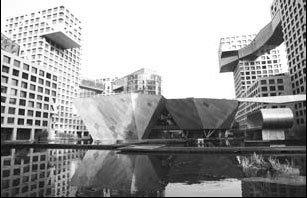Building with brains and beauty beijing
|
The Grand MOMA, a new Beijing landmark. Wang Jing / China Daily |
Beijing
Futuristic Grand MOMA draws crowds and Todd Balazovic pays a visit.
Standing across the street from the Grand MOMA, one of Beijing's latest and greatest architectural achievements, spectators may get the idea that they are staring at an artistic masterpiece.
But, unlike the priceless paintings found in most art galleries, the Grand MOMA complex is a piece of art you can live in.
Named one of Time magazine's 10 architectural wonders in 2007, the building should tempt visitors to Beijing with a few extra hours on their hands to stroll around the contemporary surroundings of what is by far one of the cities most advanced living spaces.
Completed in late 2008 by American architect Steve Holl, the futuristic-looking apartment complex, designated by Holl as the "Linked Hybrid", mainly provides plush units targeted at expatriates.
But a variety of small, chic eateries, a hotel, and Beijing's first art-house cinema, the BC MOMA Theater, have made the site a hot spot for the city's leisure crowd.
The complex's eight large apartment towers, each a different height, are linked by skyways on the 20th floor, creating the feeling of an enclosure to visitors within the courtyard area - a sense of confinement and closeness Holl created deliberately.
"Multifaceted spatial layers, as well as the many passages through the project, make the Linked Hybrid an 'open city within a city'," he says. "People can work, live and recreate here without need for an automobile."
Pushing the posh image, the BC MOMA Theater is possibly one of the biggest attractions the space has to offer. Operated by Hong Kong's Broadway Cinema, the theater is home to several of Beijing's "alternative" film events.
"With three different halls, it has programs similar to Film Forum in New York City," says Holl, referencing New York's largest nonprofit independent theater. What sets the structure apart from the rest of Beijing's bustling skyline is the abundance of colors from each of the tower's windows.
The color selection was picked using the classic spectrum from Buddhist architecture, with references to the Chinese geomancy book I-Ching.
While visually appealing, the Grand MOMA complex flaunts as much brains as beauty, boasting some of the world's most advanced green technology. A centralized temperature control system uses more than 600 100-meter-deep water wells placed beneath the underground car park, and Holl says they are able to provide approximately three times more heating or cooling for the same energy as normal systems.
The building uses natural ground temperature as a source of some of the most energy efficient heating and cooling available.
"The client originally asked for maximum green aspects," Holl says. "They understood there is a good argument for promoting the project by highlighting the technology, and in the end it has already paid itself back."
(China Daily 11/14/2010 page15)















